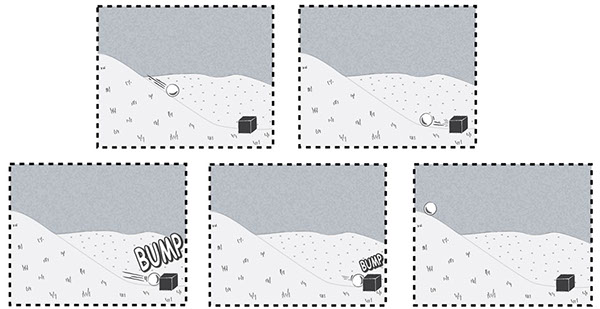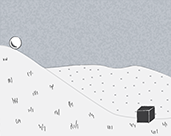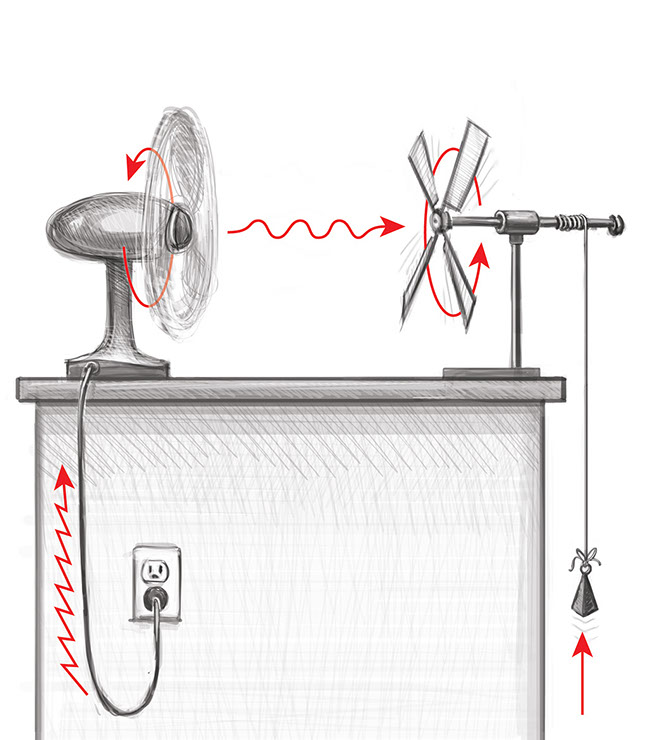SciGen Teacher Dashboard
Unit E1
Potential and Kinetic Energy
Scene: Keeping Track of Energy
Duration: Approximately 75 minutes
 In this Science Scene, a dialogue to read aloud as a class, students meet characters discussing their science homework about kinetic and potential energy. The students are confused about the terms and do not understand the homework. But as the students talk, they reveal that they actually have a basic understanding of the concepts.
In this Science Scene, a dialogue to read aloud as a class, students meet characters discussing their science homework about kinetic and potential energy. The students are confused about the terms and do not understand the homework. But as the students talk, they reveal that they actually have a basic understanding of the concepts.
Like the fictional students, your students will not have a clear understanding of the concepts after reading this passage. But that is okay, as this section is an introduction to the concepts.
The activity ends with a look at the three solutions of the fictional students featured in the dialogue; two have errors, one does not.
LEARNING OBJECTIVES
Students explore the scientific language used in studying potential and kinetic energy.
Students practice using this important vocabulary and scientific terminology.
Teacher Tips
- Think ahead about how you will assign the four roles (Ms. Quintanilla, Cooper, Olivia, and Hamza) to read the script aloud as a class (or, less ideally, in small groups). Note that students often willingly take on roles regardless of the gender of the characters.
- A live demonstration of the fan and the pinwheel is easy to set up. Even without the weight wound on the dowel it may be helpful for student to see this image.
- While it is possible for the students to read the PDF of the script online, we suggest printing the script for the students so they can hold it in their hands and mark it as they read. Consider scaffolding the lesson for English language learners: you could let them preview the script before the lesson or read the dialogue silently once and ask questions to a partner.
- Prior to the reading the script, explain to students that they will encounter new vocabulary terms and ideas that may not be familiar. Reassure them that this lack of familiarity is okay. The reading is meant to introduce the ideas, not explain them completely.
- Review the focus words of the week. The focus word chart linked on the unit overview page should be used as a resource for students to review definitions and sample sentences.
- This lesson can be accompanied by watching complicated Rube Goldberg machines (also known as Pythagoras Switch or Heath Robinson contraptions). Some popular ones are Peter Fischli and David Weiss art piece "The Way Things Go" (1987) excerpted at the Guggenheim Museum or in its full 30-minute version, interstitials made by the Japanese educational TV program Pitagora Suitchi, or OKGo's music video This Too Shall Pass.
Materials (one per student or group)
- optional: electronic device (such as computer, laptop, tablet) to use the interactive elements, if not looking at them as a class
Teacher Tune-ups
Teaching Notes
ACTIVITY OVERVIEW
- Set the context (10 minutes)
- Engage with the script (30 minutes)
- Think through the hillside problem (15 minutes)
- Analyze Hamza's, Cooper's, and Olivia's homework (20 minutes)
Set the context (10 minutes)
Display the image and encourage students to turn and talk in order to make sense of the illustration.
:
- What do you think is going on?
- What might the arrows represent?
- Is the windmill doing any work?
Engage with the script (30 minutes)
Consider choosing four students to read aloud the four parts. Assign a fifth student to be the narrator and to read the italicized sentences.
It may help to have your students read the dialogue about the fan that causes the string to wind around the shaft twice.
:
Think about this drawing. The fan is blowing air. What will the blowing air move?
- The model of a windmill will turn.
What will happen as the windmill turns?
- The string will wind around the windmill’s shaft and the weight will be pulled up.
You may wish to ask students what Olivia says about the objects in the drawing. (Note that Olivia mentions that it is a “weird energy system” that “is storing up energy.”) These are key concepts that will be explored throughout the unit.
Setting: Cooper, Olivia, and Hamza had a hard time with their science homework last night. They’re talking in the hallway before class.
Cooper: You look half dead, Hamza. Here, take my energy bar.
Hamza: Thanks. I get that the bar will give me some energy, but I did not get last night’s homework about energy. Did you?
Olivia: Hi guys! I thought the homework was confusing, too. It said something about energy having to do with things moving, but energy bars don’t move. At least not like a ball or a wave does.
Cooper: Maybe they’re called energy bars because they can make people move more when they eat them? I don’t know, though.
Hamza: I thought energy was electricity that makes stuff work, like lights.
Olivia: Maybe energy can do a lot of different things. But then why bother with the word “energy”? Why don’t we just say “food” when we mean food and “electricity” when we mean electricity?
Hamza: I think that this energy bar is working. I feel better. My energy had gone on vacation, and now it’s...coming home.
Cooper: You know, your energy might have come back, but the energy we are studying never goes away, it just changes. Look...
He pulls out his homework and points to this graphic:
Cooper: Remember how the energy of the sliding book was slowed down by friction so the table and the book got hotter? Well, probably just a little hotter. Anyway, that’s where the energy went, into heat.
Olivia: Are you saying that hotter people use more energy? Well, that means that Hamza...
Hamza: (cutting her off) Don’t go there, Olivia.
Cooper: (changing the subject) Look at the next picture. We’re supposed to explain what’s going on in terms of energy.
Olivia: Whoa, there’s a lot going on there. It’s confusing. It’s like everything is all connected. How can you even keep track of what you’re talking about?
Hamza: The fan is winding up the thing attached to the stand. When you turn the fan off the mass is going to drop back down because of gravity. What a crazy setup.
Olivia: You totally could have done your homework if you’d tried. You got that way faster than I did. So this weird energy system is storing up energy as the string gets wound up.
Cooper: Yeah. The kinetic energy involved in the winding up is getting switched over to potential energy.
Hamza and Olivia: Huh?
Ms. Quintanilla: Sorry, guys. I couldn’t help eavesdropping because I was so impressed with your comments. Especially yours, Olivia, about the challenge of keeping track of different parts of a system.
Olivia: I said that? Uh, I mean thanks, Ms. Q!
Ms. Quintanilla: System is a great word in science because it’s flexible. It’s like drawing an imaginary boundary around a portion of the real world and studying how the parts within it work together. Let’s look at the last part of your homework with that hillside problem.
Hamza: That was hard!
Ms. Quintanilla: It’s supposed to be hard. When things are easy you’re not really learning, you’re just performing. Remember that these exercises were supposed to help you begin thinking about energy. If you’re struggling, that means you’re thinking! We’ll discuss them right now in class.
Hamza: Oh good. I’m glad. I didn’t understand what you meant by potential and kinetic, either.
Ms. Quintanilla: Excellent question. We’ll go over that as well.
They all walk into the classroom. Ms. Q asks the class to look at five images of the hillside (part of their homework). She tells the members of each table group to compare answers and to discuss their thinking. Cooper, Hamza, and Olivia are sitting at the same table, and they all have different answers to the problem. Here’s how the problem looked on their worksheet:

The five illustrations show an energy system but they aren’t in the correct order. Think through how the energy would move through this system. Then cut out the the images and tape them on another piece of paper in the correct order.
Ms. Quintanilla: In fact, we can use these little pictures to help us with a few more helpful terms we need to learn: momentum, acceleration, velocity, and inertia.
Olivia: I hear the first two of those words all the time. Our lacrosse coach talks about momentum a lot.
Hamza: And you hear about acceleration in car commercials.
Ms. Quintanilla: Great! Well, let’s talk about the science so you can see why coaches and advertisers like the terms so much.
Ms. Q draws on the whiteboard:
Cooper: (under his breath) I’m glad she’s our science teacher and not our art teacher...
Ms. Quintanilla: (to the entire class) My extra credit starter challenge for you all today is to look at the last problem of your homework, the one with the hillside, and to add a caption that describes what’s happening in the sequence. But try to use the terms I’ve written on the whiteboard correctly as you write.
Hamza: Extra credit? Awesome. This will help make up for the other times when I didn’t have the energy to do my homework.
Olivia: I say again Hamza, not an energy problem...an attitude problem.
Hamza: Whatever.
Think through the hillside problem (15 minutes)
Analyze Hamza's, Cooper's, and Olivia's homework (20 minutes)















Below are clippings from Hamza’s, Cooper’s, and Olivia’s homework assignments. Evaluate their sequences and captions and then answer the questions about their work.
The ball on top of the hill is still because of inertia. The ball’s velocity increases as it goes down the hill. The block stops the momentum of the ball so it’s not accelerating.
Here is Hamza's work:
The ball had lots of momentum, so there’s a big BUMP because inertia would cause the block to want to stay still and the ball to keep rolling. The second time the ball hit the block there’s less velocity because it did not roll down the whole hill.
The velocity increases and that is acceleration. The block doesn’t move very much when it is hit because of inertia and friction.
Here is Cooper's work:
Here is Olivia's work:
Have students look at the answers given by Hamza, Cooper, and Olivia and 1) determine if the panels are in the correct order, and 2) rewrite the caption to improve it.
It will probably help to tell students that Hamza misread two visual clues in his third panel.
:
- The ball in this panel has curved lines to the right of the ball. This indicates that the ball is going to the left. And the block is further right than the previous two panels, indicating that the block had already been hit. Hamza probably missed these visual clues. Notice that Hamza puts the big “bump” first. He may have thought the ball hit the block twice in quick succession. In this case, it would make sense to put the image with the big “bump” first, before the smaller “bump.”
- Cooper’s sequence is correct. Cooper’s caption is also correct.
- Olivia reversed the two “bump” panels. It may help to ask students why they think she did this. She may not have been paying attention. Or she may not realize that the ball has more momentum the first time it hits the block, so the first bump needs to biggest.
BETA Version - Please send comments and corrections to info@serpinstitute.org




